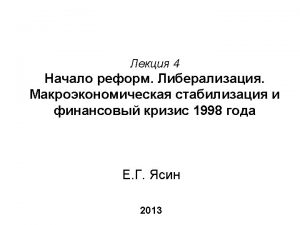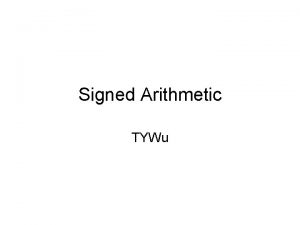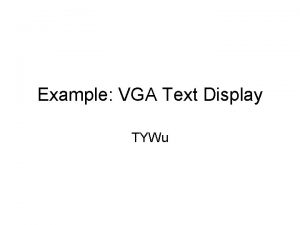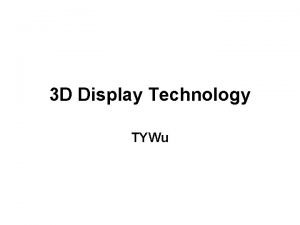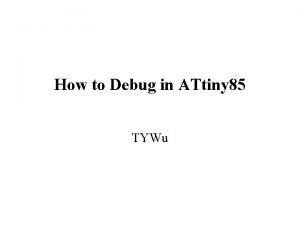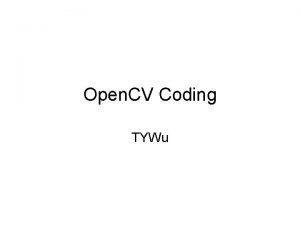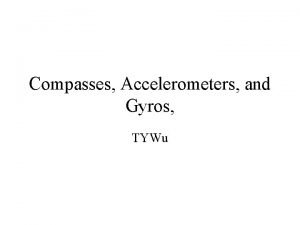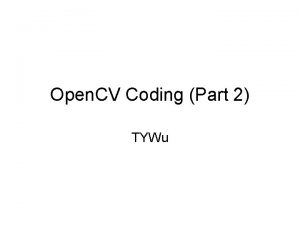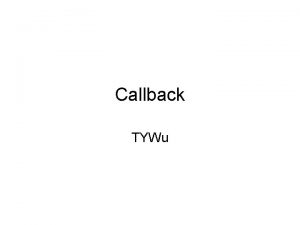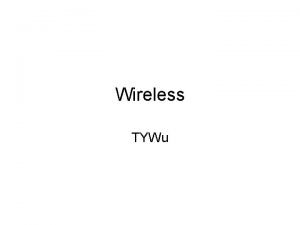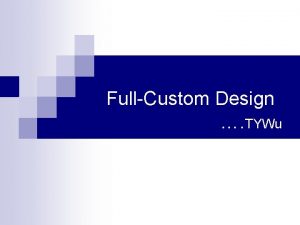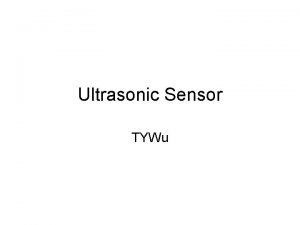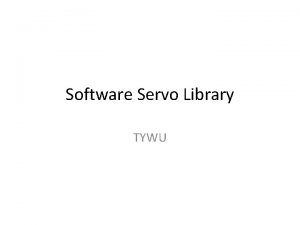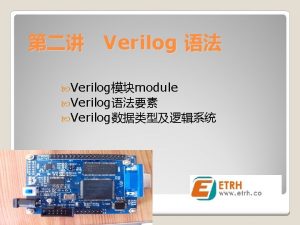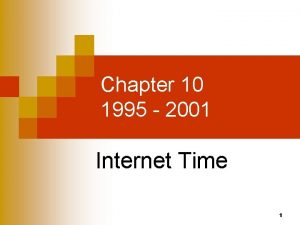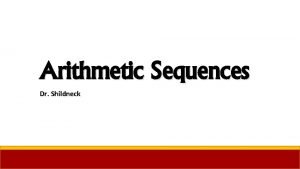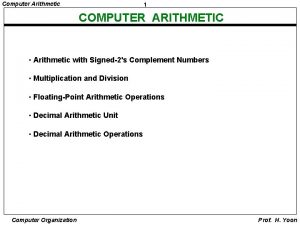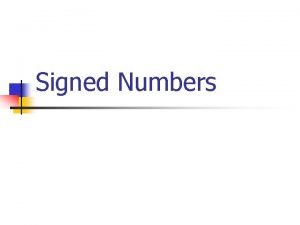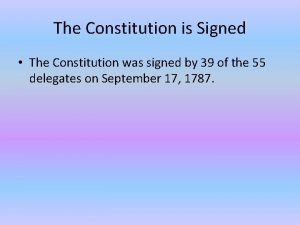Signed Arithmetic TYWu Verilog 2001 Verilog 1995 provides








![Signed Addition • Unsigned Example module add ( input [2: 0] A, input [2: Signed Addition • Unsigned Example module add ( input [2: 0] A, input [2:](https://slidetodoc.com/presentation_image_h2/3bfb3ce5af182c2e1f647ace20b85a76/image-9.jpg)

![Signed Multiplication • Example for Verilog 1995 module mult_signed_1995 ( input [2: 0] a, Signed Multiplication • Example for Verilog 1995 module mult_signed_1995 ( input [2: 0] a,](https://slidetodoc.com/presentation_image_h2/3bfb3ce5af182c2e1f647ace20b85a76/image-11.jpg)
![Signed Multiplication assign prod_intermediate 0 = b[0] ? {{3{a[2]}}, a} : 6'b 0; assign Signed Multiplication assign prod_intermediate 0 = b[0] ? {{3{a[2]}}, a} : 6'b 0; assign](https://slidetodoc.com/presentation_image_h2/3bfb3ce5af182c2e1f647ace20b85a76/image-12.jpg)
![Signed Multiplication • Example for Verilog 2001 module mult_signed_2001 ( input signed [2: 0] Signed Multiplication • Example for Verilog 2001 module mult_signed_2001 ( input signed [2: 0]](https://slidetodoc.com/presentation_image_h2/3bfb3ce5af182c2e1f647ace20b85a76/image-13.jpg)

- Slides: 14

Signed Arithmetic TYWu

Verilog 2001 • Verilog 1995 provides only one signed data type, integer. • Verilog 2001 provides a very rich set of new signed data types. However, there are issues when performing operations – sign extension – truncation or rounding, – saturation, addition, and multiplication with signed values.

Decimal to 3 -bit Signed • Table

Type Casting • The casting operators, $unsigned and $signed, only have effect when casting a smaller bit width to a larger bit. – A = $unsigned(B) will zero fill B and assign it to A. – Casting using $signed(signal_name) will sign extend the input. • For example, A = $signed(B). – If the sign bit is X or Z the value will be sign extended using X or Z, respectively.

Type Casting • Assigning to a smaller bit width signal will simply truncate the necessary MSB’s as usual. • Casting to the same bit width will have no effect other than to remove synthesis warnings.

Signed Based Values • 2 represented as a 3 -bit signed hex value would be specified as 3’sh 2. • Somewhat confusing is specifying negative signed values. The value -4 represented as a 3 -bit signed hex value would be specified as -3’sh 4. • A decimal number is always signed.

Signed Addition • Example for Verilog 1995 – Adding two values that are n-bits wide will produce a n+1 bit wide result module add_signed_1995 ( input [2: 0] A, input [2: 0] B, output [3: 0] Sum ); assign Sum = {A[2], A} + {B[2], B}; endmodule // add_signed_1995 Manually Add

Signed Addition • Example for Verilog 2001 – We can use the new signed type Automatic! module add_signed_2001 ( input signed [2: 0] A, input signed [2: 0] B, output signed [3: 0] Sum ); assign Sum = A + B; endmodule // add_signed_2001
![Signed Addition Unsigned Example module add input 2 0 A input 2 Signed Addition • Unsigned Example module add ( input [2: 0] A, input [2:](https://slidetodoc.com/presentation_image_h2/3bfb3ce5af182c2e1f647ace20b85a76/image-9.jpg)
Signed Addition • Unsigned Example module add ( input [2: 0] A, input [2: 0] B, output [3: 0] Sum ); assign Sum = A + B; endmodule 110 + 011 1001

Signed Multiplication • Example 3’b 101 == -3 -1*22 + 0*21 + 1*20
![Signed Multiplication Example for Verilog 1995 module multsigned1995 input 2 0 a Signed Multiplication • Example for Verilog 1995 module mult_signed_1995 ( input [2: 0] a,](https://slidetodoc.com/presentation_image_h2/3bfb3ce5af182c2e1f647ace20b85a76/image-11.jpg)
Signed Multiplication • Example for Verilog 1995 module mult_signed_1995 ( input [2: 0] a, input [2: 0] b, output [5: 0] prod ); wire [5: 0] prod_intermediate 0; wire [5: 0] prod_intermediate 1; wire [5: 0] prod_intermediate 2; wire [2: 0] inv_add 1;
![Signed Multiplication assign prodintermediate 0 b0 3a2 a 6b 0 assign Signed Multiplication assign prod_intermediate 0 = b[0] ? {{3{a[2]}}, a} : 6'b 0; assign](https://slidetodoc.com/presentation_image_h2/3bfb3ce5af182c2e1f647ace20b85a76/image-12.jpg)
Signed Multiplication assign prod_intermediate 0 = b[0] ? {{3{a[2]}}, a} : 6'b 0; assign prod_intermediate 1 = b[1] ? {{2{a[2]}}, a, 1'b 0} : 6'b 0; // Do the invert and add 1 of a. assign inv_add 1 = ~a + 1'b 1; assign prod_intermediate 2 = b[2] ? {{1{inv_add 1[2]}}, inv_add 1, 2'b 0} : 6'b 0; assign prod = prod_intermediate 0 + prod_intermediate 1 + prod_intermediate 2; endmodule
![Signed Multiplication Example for Verilog 2001 module multsigned2001 input signed 2 0 Signed Multiplication • Example for Verilog 2001 module mult_signed_2001 ( input signed [2: 0]](https://slidetodoc.com/presentation_image_h2/3bfb3ce5af182c2e1f647ace20b85a76/image-13.jpg)
Signed Multiplication • Example for Verilog 2001 module mult_signed_2001 ( input signed [2: 0] a, input signed [2: 0] b, output signed [5: 0] prod); assign prod = a*b; endmodule

Advanced Topics • Recall the rule that if any operand of an operation is unsigned the entire operation is unsigned. • When synthesized the following warning occurs: signed to unsigned conversion occurs. (VER-318). • Now if we multiply – 3 (3’b 101) by 2 (3’b 010) as usual with this code we get 0 x. A (6’b 001010).
